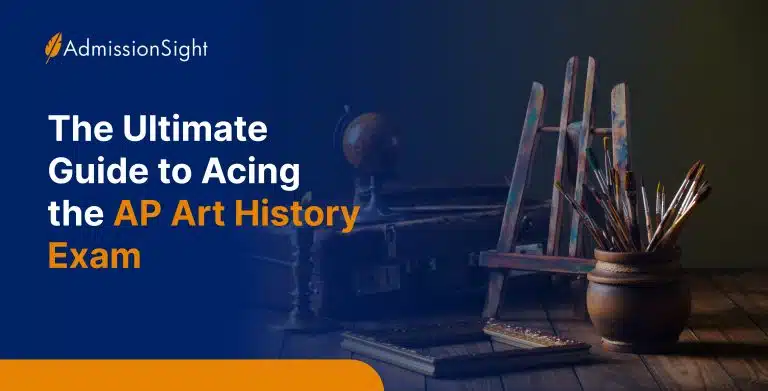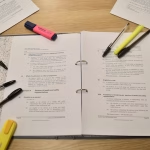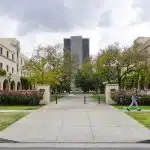In 2024, 27,362 students took the AP Art History Exam. The average score was 3, and 62.7% of students scored a 3 or higher. That’s a decent pass rate, but it also shows that this test is no walk in the park. If you want a top score, memorization alone won’t get you there.
This guide covers the AP Art History Exam format, image set, question types, study tips, scoring trends, and test-taking strategies to help you get ready for the 2025 exam.
- AP Art History Course and Exam Description
- AP Art History Exam Format
- AP Art History Exam Questions
- How to Study for the AP Art History Exam
- AP Art History Exam Test-Taking Tips
- AP Art History Exam Date
- Is the AP Art History Exam Hard?
- Frequently Asked Questions
- Takeaways
AP Art History Course and Exam Description
AP Art History is a global, college-level course where you explore works of art from prehistory to the present. Instead of just memorizing titles and dates, you’ll be asked to think about how, when, and why these artworks were made. That means analyzing materials, context, and function while comparing visual forms and themes across cultures.
The required course content includes 250 works of art selected by the College Board. These works come from ten content areas, including Indigenous Americas, Africa, West and Central Asia, South, East, and Southeast Asia, the Pacific, and both ancient and modern Western art.
The class is designed to be as rigorous as a two-semester introductory college course. If you’ve never taken an art course before, it can feel overwhelming at first, but with repetition and structured study, the big picture starts to come together.
The exam will test not only your ability to recall information but also your skill in comparing works, identifying visual and contextual features, and writing clear arguments.
AP Art History Exam topics
The AP Art History Exam organizes content by culture, region, and time period. Here’s how the 250 required works are distributed across the ten content areas:
|
Content Area |
Approximate Number of Works |
|
Global Prehistory |
11 |
|
Ancient Mediterranean |
36 |
|
Early Europe and Colonial Americas |
51 |
|
Indigenous Americas |
14 |
|
Africa |
11 |
|
West and Central Asia |
11 |
|
South, East, and Southeast Asia |
21 |
|
The Pacific |
11 |
|
Later Europe and Americas |
51 |
|
Global Contemporary |
27 |
These groupings reflect not just geography but also thematic trends in art across civilizations. For example, the Ancient Mediterranean section focuses heavily on Greek, Roman, and Egyptian art, while Global Contemporary highlights work made after 1980 by artists from around the world.
Each content area is linked to specific skills you’ll be tested on, like contextual analysis, comparison, and formal analysis. You’ll also need to understand overarching themes such as power, identity, belief systems, and the human body.
The image set is not just a list to memorize. It’s the foundation for understanding artistic traditions, innovations, and influences across time and space.
Some units appear more frequently on the exam than others. While the exact number of questions per unit may vary from year to year, expect to see more questions from the Ancient Mediterranean, Early Europe, and Later Europe content areas, since those units contain the largest number of works.
AP Art History Exam Format
The AP Art History Exam is split into two sections:
- Multiple-Choice Questions (MCQs)
- Free-Response Questions (FRQs)
Each section makes up 50 percent of your final score, so you’ll need to prepare for both. Here’s a quick breakdown:
Section I: Multiple-Choice Questions
- 80 questions
- 1 hour
- Based on individual images and sets of images
- Some questions are purely visual, others ask for context or comparisons
First up, the multiple-choice section. You’ll have 60 minutes to answer 80 questions. These will include both individual questions and question sets based on pairs or groups of images. The questions test your ability to identify works, analyze form and context, and make art-historical comparisons.
Section II: Free-Response Questions
- 6 questions total
- 2 long essays and 4 short essays
- 2 hours
The FRQ section lasts 120 minutes. You’ll answer six questions: two long essays and four short essays. These will ask you to analyze visual and contextual elements, attribute works, compare pieces, and discuss artistic continuity and change. Clear, structured writing is essential here.
How long is the AP Art History Exam?
The exam runs for three hours total, split between the two sections. For the MCQs, you’ll get about 45 seconds per question. In the FRQ section, time management matters even more. You should spend around 25 minutes on each long essay and about 10 minutes on each short one.
Balancing depth and speed is the challenge. If you rush, your arguments will lack support. If you go too slow, you won’t finish. Knowing the format in advance helps you plan your pace and avoid last-minute panic.
AP Art History Exam Questions
Both the multiple-choice and free-response sections test how well you understand the works from the image set and how confidently you can apply your art-historical thinking to new prompts. More than just identifying what’s in front of you, you’ll need to describe, analyze, compare, attribute, and justify.
Multiple-Choice Questions
You’ll have 60 minutes to complete 80 multiple-choice questions. These questions test your ability to identify works of art, recognize stylistic and cultural traits, and analyze both visual and contextual information. About half of the questions are image-based. Some focus on a single work, while others compare two.
Here’s a real example set from the College Board’s official 2011 Slide-Based Multiple-Choice Questions and Free-Response Questions release:
|
1. The work is from which culture? 2. The medium of the work is 3. The work is 4. Works such as the one shown were typically placed in 5. The work depicts a |
All five questions refer to the Sarcophagus of the Spouses, one of the 250 required works in the image set. This funerary sculpture was created around 520 BCE by the Etruscans.
- The correct answer to Question 1 is C (Etruscan). You can tell by the stylized facial features, relaxed pose, and terra-cotta medium. Etruscan sculpture often emphasizes human expression and gesture, with a warmth and liveliness that differs from Egyptian rigidity or Greek idealization.
- For Question 2, the correct answer is A (terracotta). The entire sculpture is made of baked clay. You can see this from the smooth surface and hollow form, which are typical of large-scale Etruscan terracotta work. They preferred this material because it was more accessible and easier to shape than marble or bronze.
- Question 3 is D (a sarcophagus). While the reclining couple looks like they’re relaxing at a banquet, this was actually a coffin used to hold cremated remains. Etruscan sarcophagi often depict scenes of daily life or affection, highlighting their cultural focus on personal identity and family ties.
- The answer to Question 4 is B (a necropolis). These large cemeteries were located outside Etruscan cities and were meant to resemble towns for the dead. Sarcophagi like this one were placed in tomb chambers alongside other grave goods.
- Question 5’s answer is C (husband and wife). This is a rare depiction of marital intimacy in ancient funerary art. The man and woman are shown reclining together in a tender, equal posture, with both figures actively engaging the viewer. This reflects the relative social status of Etruscan women, who had more visibility and freedom than their Greek or Roman counterparts.
Practicing with sets like this builds your confidence in identifying works quickly and accurately. But remember: it’s not just about memorization. It’s about using visual clues and contextual knowledge to support your choices.
Free-Response Questions
The FRQ section is where you show what you really know. You’ll have 2 hours to answer six questions: two long essays and four short essays. These questions go beyond memorization. They ask you to compare works, justify claims, attribute unfamiliar images, and explain how context or meaning is communicated through form.
Here’s a real sample question from the 2024 AP Art History Free-Response Questions, released by the College Board:
|
Question 1 refers to the following two images: 1. The work shown is the Screen with the Siege of Belgrade and Hunting Scene, attributed to the Circle of the González family c. 1697–1701 CE. The materials and subject matter in the work demonstrate interaction between different cultures.
|
The Screen with the Siege of Belgrade and Hunting Scene is a large, two-sided folding screen from New Spain (modern-day Mexico). One side shows a chaotic European battle scene based on a Flemish print. The other side displays a peaceful hunting scene inspired by Japanese screens.
It’s made of oil paint on wood with shell inlay, a technique called enconchado, which reflects Asian influence. This object is a hybrid of Japanese folding screens (byōbu), Spanish baroque aesthetics, and indigenous craftsmanship—all wrapped into one elite commission for the Spanish colonial elite.
So, what would a strong answer look like? A good response would select a second work that also demonstrates cultural exchange.
One strong option is the Great Mosque of Djenné in Mali, which combines Islamic religious function with traditional West African mud-brick architecture. Another option might be the Dome of the Rock, showing Byzantine influence in an Islamic religious context.
A high-scoring response would:
- Describe the Screen with the Siege of Belgrade and Hunting Scene as a two-sided folding screen made in New Spain around 1700, using oil paint, wood, and mother-of-pearl inlay. One side shows a European battle scene, while the other features a Japanese-style hunting scene inspired by folding screens from Asia.
- Identify the comparison work with specific visual details, such as the Great Mosque of Djenné’s monumental adobe structure, toron beams, and three large minarets, or the Dome of the Rock’s octagonal layout, large golden dome, and colorful mosaics using Byzantine techniques.
- Explain that both works visually reflect interactions between cultures, with the Screen blending Spanish colonial subject matter and Asian materials, and the second work blending imported religious forms with regional traditions.
- Point out that the Screen was created for secular elite display in a private residence, while the mosque or shrine was built for religious practice and public use.
- Support a claim using historical context, such as how the Manila Galleon trade connected New Spain to Asia and introduced lacquer techniques, or how Islamic patrons in Mali or Jerusalem used architecture to assert authority and connect with broader religious traditions.
- Use accurate titles, dates, and terminology throughout the response, and organize the answer clearly so each part of the prompt is fully addressed.
These questions demand clarity and precision. Always refer to works by their full titles, be specific with your evidence, and stay focused on the task in the prompt. Strong writing and structure will make a big difference in your score.
If you want to improve, review sample responses from the College Board. Seeing actual student answers and how they’re scored can help you refine your approach and make sure you’re hitting all the key points.
How to Study for the AP Art History Exam
To do well on the AP Art History Exam, you need to recognize patterns across cultures, explain how art reflects its context, and write clearly about what you see. The best way to prepare is to focus on the works that matter most, practice the types of questions you’ll be asked, and get comfortable writing under time pressure.
1. Know what’s in the image set.
Start with the 250 required works. These are the core of the course and form the foundation of the exam. For each work, make sure you know the culture or artist, title, date or period, materials, location, and function. But do more than memorize. Ask what makes the piece visually distinct and what it tells you about the people who created it.
The AP Art History Course and Exam Description organizes the works into 10 content areas. Pay attention to units that contain more works, like Later Europe or the Ancient Mediterranean. The more works in a unit, the more likely it will show up on the test.
If a unit has fewer works, it may only appear once. Units with 40 or 50 works can appear several times, so they deserve more of your review time.
2. Practice with timed exams.
Taking full-length practice tests is one of the best ways to build endurance and confidence. You’re not just being tested on what you know but on how well you manage your time and think under pressure.
After each test, reflect on your performance:
- Which areas caused the most confusion? Maybe you mix up Pacific and African art, or forget key features of South and Southeast Asian pieces
- What’s the reason behind your mistakes? Did you confuse similar styles? Miss a visual clue? Skip a step in a short essay?
- Are you finishing on time? You get 45 seconds per multiple-choice question. The free-response section gives you about 10 minutes for short essays and 25 minutes for long ones.
Try to replicate real test conditions as much as possible. Use official past AP Art History exams and avoid pausing or checking notes mid-test. Practicing with pressure makes the real exam feel more manageable.
3. Study with images, not just outlines.
This is a visual subject, so your study habits should match. Reading notes is helpful, but make sure you spend just as much time looking at the images. Notice the shapes, lines, textures, and materials. Pay attention to how figures are arranged and how space is used.
Flashcards help, but only if you are testing yourself on more than titles. Ask how the work was used, what it symbolizes, and what culture it came from. If you can’t explain the piece in your own words, you probably need more review.
Group works thematically. For example, collect a few that deal with funerary practices, religious rituals, or royal authority. Comparing them across cultures makes it easier to prepare for essays that ask about change or continuity.
4. Learn how to write about art.
The free-response section is half your score. You won’t get credit just for knowing facts. You need to explain, compare, describe, and support your claims with solid evidence.
To improve your writing:
- Practice describing what you see in plain, accurate language.
- Explain what those visual features mean in context.
- Use historical or cultural background to support your claims, even when not directly asked.
- Answer all parts of each prompt, and label each section clearly.
- Be specific with titles, dates, and materials whenever you can.
Start by writing short responses to sample prompts. Set a timer. After writing, check your answer against scoring guidelines or sample responses. See what you included, what you missed, and how you can be more direct next time.
5. Look for patterns across the course.
With 250 works, it’s easy to feel like you’re studying a list. But once you step back and group pieces by purpose or theme, the exam starts to make more sense.
Ask questions like:
- Which works were created for rulers or governments?
- Which ones were used in religious ceremonies?
- Where do you see cultural blending or influence?
- What changes when a culture adopts a new religion or form of government?
These patterns come up often in essays and short answers. If you can recognize them quickly and support your answer with clear examples, you’ll be in a strong position on test day.
AP Art History Exam Test-Taking Tips
Studying is important, but how you manage the exam itself matters just as much. Many students lose points not because they don’t know the material, but because they rush, misread prompts, or leave questions unfinished.
This section walks you through strategies to help you stay focused, use your time well, and avoid common mistakes.
1. Stick to a realistic time plan.
The AP Art History Exam takes three hours total. You get 60 minutes for the multiple-choice section and 120 minutes for the free-response section. Both sections are worth 50 percent of your total score, so pacing is key.
In the MCQ section, you’ll answer 80 questions in 60 minutes. That’s just 45 seconds per question. Some will be quicker if you know the work well. Others will require more time to analyze an unfamiliar image or figure out a comparison.
Don’t get stuck on one question. If you’re unsure, take your best shot, mark it, and move on. You can return to it if you have time left.
The FRQ section often causes time issues. You’ll have six prompts: two long essays and four shorter ones. Each question is scored separately, so if you skip one, that’s a lot of points off the table.
Try to spend about 25 minutes on each long essay and 10 minutes on each short one. Keep an eye on the clock. Write with purpose, but don’t get stuck overthinking the perfect phrase.
If you haven’t practiced writing with a timer, start now. Learning to pace yourself while staying clear and complete is one of the best ways to boost your score.
2. Read each question like it counts.
Plenty of avoidable mistakes happen because students skim the prompt. But AP Art History FRQs often contain multi-part instructions, and missing even one part can cost you points.
If the question asks you to describe a work, then compare it to another, and then explain their historical connection, you need to answer all three. Leaving one out is like turning in an unfinished assignment.
To stay on track:
- Underline action words like describe, explain, identify, justify, or attribute. Each one signals a different kind of answer.
- Check for prompts with multiple sub-questions. If it says (a), (b), and (c), make sure your response has all three.
- Watch out for prompts asking for evidence or context. Don’t just talk about what the work looks like. Talk about what it means, how it was used, or why it matters.
- If the question includes images or cultural information, slow down and absorb it before you start writing. It’s not always just background. Sometimes it’s the key to your answer.
3. Use smart elimination on multiple-choice questions.
Even if you don’t know the exact answer, you can still improve your odds by ruling out the worst options. Some answers will be completely off, while others might include one correct detail but miss the full picture.
Here’s how to narrow things down:
- Cross off anything that contradicts what you know. If the material is wrong or the function doesn’t fit, eliminate it.
- Be careful with extreme choices. Answers that say always, only, or never are usually too rigid for art history.
- Compare remaining choices and pick the one that fits the question best. If two seem close, go back to the phrasing of the prompt and reread carefully.
- Guess if you’re stuck. There’s no penalty for guessing, so don’t leave anything blank.
Trust what you’ve studied. Even if you don’t recognize the image, your understanding of visual elements, time periods, and regional traits can still guide you to the right answer.
4. Make every free-response answer count.
The FRQs are not all-or-nothing. You can still earn points even if your answer isn’t perfect. The goal is to demonstrate what you know and show that you understand how to use evidence, not just memorize facts.
To get the most out of every response:
- Label each part of your answer clearly if the prompt has separate sections.
- Use full sentences and explain your ideas completely. One-word or list-style answers won’t get credit.
- Be as specific as possible. Use the full name of the work, note the region or time period, and include materials and function when relevant.
- If the prompt asks you to justify a claim, connect the artwork’s features to a broader historical or cultural point.
- If you don’t know the full name of a work, but recognize it, describe it clearly. You may still earn partial credit if the grader can tell what you mean.
- Write something for every question. A partial answer that shows effort is better than a blank page.
Remember, the graders are looking for understanding, not perfection. They want to see that you can analyze, connect, and explain. The more clearly you do that, the better your score.
AP Art History Exam Date
The AP Art History Exam is scheduled for Thursday, May 15, 2025, at 8 AM local time. This is the official College Board date for the paper exam. If you’re taking it through your school, plan to arrive early and bring everything you need: pencils for the multiple-choice section, pens for the free-response, and your AP ID.
To find test dates for other AP exams and registration details, check out our comprehensive guide.
AP Art History Exam score release date
AP scores for 2025 will start rolling out on July 7, according to the College Board’s official schedule. That includes subject score reports, student score reports, and summary data. Students typically gain access to their individual scores on this same day through their College Board account.
Additional reports like the Student Datafile and Scholar Award Reports will be released on July 14. To avoid delays or login issues, double-check your College Board account details before score release day. Make sure your email, password, and security info are still up to date.
Is the AP Art History Exam Hard?
AP Art History isn’t the most popular AP exam, but it’s one of the most demanding when it comes to writing. You’ll need to memorize 250 works, know their cultural context, and be able to write clearly about how and why those works were made.
You won’t just be asked to identify images. You’ll need to compare artworks, explain historical meaning, and back up your claims with visual or contextual evidence. That’s a lot to juggle, especially in timed conditions.
If you’re wondering how students usually perform, here’s the score breakdown from the 2024 exam:
|
Score |
Percentage of Students |
|
5 |
13.9% |
|
4 |
21.5% |
|
3 |
27.2% |
|
2 |
24.8% |
|
1 |
12.5% |
|
Total Passing (3+) |
62.7% |
A mean score of 3.00 puts AP Art History in the middle of the difficulty scale. Roughly 6 out of 10 students earned a passing score of 3 or higher, but fewer than 1 in 7 earned a 5.
That means getting a top score takes strategy. You need a strong understanding of the image set, clear writing, and enough practice with free-response questions to manage your time and structure your thoughts.
If you need structured help, check out our AP tutorial services. We break down tricky topics, walk you through practice questions, and help you develop test-taking strategies that actually work.
Frequently Asked Questions
1. How hard is the AP Art History Exam?
AP Art History is moderately difficult. In 2024, 62.7% of students scored a 3 or higher, but only 13.9% earned a 5. The test asks you to recognize images, explain visual features, and write clearly about historical context—all under time pressure.
It’s more writing-heavy than AP Environmental Science and more specialized than AP World History, but usually less abstract than AP English Literature. Strong visual memory and clear writing will take you far.
2. How many hours should you study for the AP Art History Exam?
It depends on how strong your background is, but most students need 80 to 100 hours of prep. If you’re aiming for a 4 or 5, a good rule is to study 3 to 5 hours per week for at least three to four months. Start by reviewing the image set regularly, then focus on practice essays, comparison prompts, and multiple-choice timing.
The most important thing is consistency. Spread your prep out so you can review the 250 required works more than once and learn how to explain them clearly in writing.
3. Do you need to memorize everything for the AP Art History Exam?
No, but you do need to recognize each of the 250 required works and know the basics: culture or artist, title, date, materials, and function. You’ll also need to explain the visual features and historical context when asked. That means understanding why the artwork was made, how it looks the way it does, and what it meant to the people who used it.
This is not a test where memorization alone will get you a 5. You have to apply what you know in response to images and writing prompts. The more you practice explaining works out loud or in short paragraphs, the easier this becomes.
4. Is AP Art History worth taking?
If you’re interested in art, history, architecture, or cultural studies, definitely yes. Many colleges give credit for a score of 4 or 5, especially if you’re applying to a liberal arts or humanities-focused program. Even if credit isn’t offered, doing well in AP Art History shows that you can handle college-level reading, analysis, and writing.
This course can also improve how you think and write across other subjects. You’ll get better at building arguments, connecting ideas across time periods, and interpreting visual information.
5. When do AP Art History scores come out?
Scores are expected to be available starting July 7, 2025, based on the College Board’s published release schedule. You can check it through College Board’s AP Scores website. If you need to send scores to a college, make sure to submit that request before the June deadline.
Takeaways
If you’re getting ready for the 2025 AP Art History Exam, here are the most important things to remember:
- The AP Art History Exam covers 250 required works from 10 global content areas. You’ll need to go beyond memorization and understand how form, function, and context work together across different cultures and time periods.
- The AP Art History Exam is split evenly between multiple-choice and free-response sections. You’ll answer 80 image-based questions and write 6 essays that test your ability to describe, compare, and explain works of art using visual and contextual evidence.
- The AP Art History Exam is three hours long, and time management is crucial. You’ll need to move quickly in the multiple-choice section and write clearly and completely in the essay section. Practice under timed conditions to build confidence.
- In 2024, only 13.9% of students scored a 5 on the AP Art History Exam, while 62.7% earned a passing score of 3 or higher. To stand out, you need specific examples, strong writing, and a clear understanding of historical and visual context.
- If you’re struggling to organize your study plan or improve your free-response writing for the AP Art History Exam, it might help to get structured guidance. A college admissions consultant can offer targeted support, personalized feedback, and proven strategies to help you earn top scores.

Eric Eng
About the author
Eric Eng, the Founder and CEO of AdmissionSight, graduated with a BA from Princeton University and has one of the highest track records in the industry of placing students into Ivy League schools and top 10 universities. He has been featured on the US News & World Report for his insights on college admissions.





















